
What is Photodiode? Mention its one use.
Answer
577.5k+ views
Hint: To get detail information about Photodiodes and its uses first of all we have to understand the operation of p-n junction diode in reverse bias mode and how the concentration of doping during fabrication of p-n junction diode opens the windows for the application of p-n junction diode in the area of optoelectronics. (Optoelectronics is the study and application of electronic devices which are specially designed to detect and control the light.)
Complete step by step answer:
Definition:
A semiconductor (special type of p-n junction) device that converts light energy into electrical energy. It works on the principle of the inner photoelectric effect. The solar cell is one great example of a photodiode.

Explanation:
It is a p-n junction device. It consumes light energy and leads to a change in the conductivity. It is used in reverse bias condition. When a light incident on the p-n junction diode, it creates electron-hole pairs that increase the conductivity in the circuit. Photodiodes are very sensitive to the incident light. It is a voltage-driven device. It has high gain along with low noise. Also, they have low sensitivity towards the temperature fluctuations, so they have a high working temperature range.

Use:
The photodiode is widely used in the measurement of the intensity of light in various research industries due to its enhanced responsiveness than photoconductors.
Note:
In order to tackle these kinds of theoretical questions, students should have to understand the concept behind the working principle of the photodiode and analyze the (I-V) characteristic curve for photodiode to grasp the In-depth theoretical concepts. One should also learn how the output current varies with changing the frequency, wavelength, and intensity of incoming radiation.
Complete step by step answer:
Definition:
A semiconductor (special type of p-n junction) device that converts light energy into electrical energy. It works on the principle of the inner photoelectric effect. The solar cell is one great example of a photodiode.

Explanation:
It is a p-n junction device. It consumes light energy and leads to a change in the conductivity. It is used in reverse bias condition. When a light incident on the p-n junction diode, it creates electron-hole pairs that increase the conductivity in the circuit. Photodiodes are very sensitive to the incident light. It is a voltage-driven device. It has high gain along with low noise. Also, they have low sensitivity towards the temperature fluctuations, so they have a high working temperature range.

Use:
The photodiode is widely used in the measurement of the intensity of light in various research industries due to its enhanced responsiveness than photoconductors.
Note:
In order to tackle these kinds of theoretical questions, students should have to understand the concept behind the working principle of the photodiode and analyze the (I-V) characteristic curve for photodiode to grasp the In-depth theoretical concepts. One should also learn how the output current varies with changing the frequency, wavelength, and intensity of incoming radiation.
Recently Updated Pages
Master Class 12 English: Engaging Questions & Answers for Success

Master Class 12 Business Studies: Engaging Questions & Answers for Success

Master Class 12 Economics: Engaging Questions & Answers for Success

Master Class 12 Social Science: Engaging Questions & Answers for Success

Master Class 12 Maths: Engaging Questions & Answers for Success

Master Class 12 Chemistry: Engaging Questions & Answers for Success

Trending doubts
What are the major means of transport Explain each class 12 social science CBSE

Which are the Top 10 Largest Countries of the World?

Draw a labelled sketch of the human eye class 12 physics CBSE

Explain sex determination in humans with line diag class 12 biology CBSE

The pH of the pancreatic juice is A 64 B 86 C 120 D class 12 biology CBSE

Explain sex determination in humans with the help of class 12 biology CBSE




